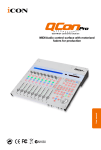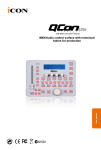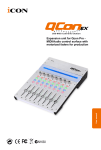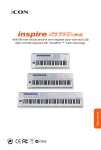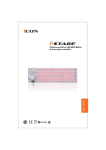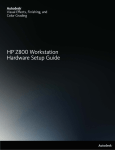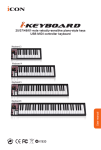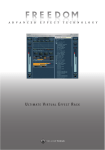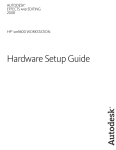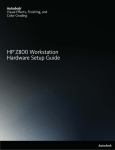Download Icon Digital AIO6 USB Interface Manual
Transcript
USB MIDI/Audio control surface N1630 Important Safety Instructions 1. Read this manual thoroughly before using this unit. 2. Keep this manual for future reference. 3. Take notice of and comply with all warnings included in the user's manual or indicated on the appliance. 4. Follow all instructions included in this manual. 5. Do not expose this unit to rain or moisture. Avoid having water or other liquids spilled on this unit. 6. When cleaning the cabinet or other parts of this appliance, use only a dry or slightly damp soft cloth. 7. Do not block any ventilation openings or interfere with the proper ventilation of this unit. Install in accordance with the manufacturer's instructions. 8. Do not use or store near any heat sources such as radiators, heat registers, stoves, or other heat-producing appliances. 9. Do not interfere with the safety purpose of the polarized or grounding-type plug. A polarized plug has two blades with one wider than the other. A grounding-type plug h as two blades and a third grounding prong. These are designated for your safety. If the provided plug does not fit into your outlet, consult an electrician. 10. Protect the power cord from being walked on or otherwise damaged by items placed on or against them. Particular attention should be given to the plugs, receptacles, and the point where the cord exits the appliance. 11. To avoid the risk of electrical shock, do not touch any exposed wiring while the unit is in operation. 12. Only use attachments/accessories specified by the manufacturer. 13. Unplug this unit and all connected electrical equipment during lightning storms or when left unused a long period of time. 14. Refer all servicing to qualified service personnel. Servicing is required when the appliance has been damaged in any way or fails to operate normally. WARNING: To reduce the risk of fire or electric shock, do not expose this unit to rain or moisture Contents Introduction What's in the package 1 1 2 Features Top Panel Layout 3-5 Left Side Panel Layout 6 Right Side Panel Layout 6 Rear Panel Layout 7 Getting Started Connecting your aio6 controller 8 Mac driver installation 9-10 Software control panel 11 Windows driver installation 12-14 Software control panel 14-15 Software control panel (continued) 15-17 iMap 18 TM Software for Mac OS X Installing iMapTM Software for Windows 18-19 iMapTM aio software panel 20-21 Firmware upgrade 22 Restore the factory default settings 22 Hardware Connections 23 Minimum System Requirements 24 Specification 24-25 Services 26 Introduction Thank you for purchasing the ICON aio6 Midi/Audio control surface. We sincerely trust this product will provide years of satisfactory service, but if anything is not to your complete satisfaction, we will endeavor to make things right. In these pages, you'll find a detailed description of the features of the aio6, as well as a guided tour through its front and side panels, step-by-step instructions for its setup and use, and full specifications. You'll also find a warranty card enclosed - please don't forget to fill it out and mail it so that you can receive online technical support at: www.icon-global.com. And so we can send you updated information about these and other ICON products in the future. As with most electronic devices, we strongly recommend you retain the original packaging. In the unlikely event the product must be returned for servicing, the original packaging (or reasonable equivalent) is required. With proper care and adequate air circulation, your aio6 will operate without any trouble for many years. We recommend that you record your serial number in the space provided below for future reference. Please write your serial number here for future reference: Purchased at: Date of purchase: What's in the package? aio6 MIDI/Audio control surface music production Driver Software CD / Manual / Quick Start Guide USB 2.0 cable Features 24-Bit 96/192KHz 6-In/6-Out USB Recording Interface 4x4 analog I/O full duplex recording and playback Dual MIC/Instrument preamps with individual gain control and phantom power switch 2 analogue line inputs on 1/4” TRS jacks 4 analog outputs on 1/4” TRS jacks S/PDIF I/O on RCA coaxial connectors 1 x 1 – 16 channel MIDI I/O 2- faders volume controls on the front panel 2 headphone output with channel 1/2 & 3/4 selectable switches and individual volume control Flexible channel routing via the software control panel 4-channel faders plus one master channel fader 5 encoder knobs Jog wheel shuttle for fast search and control Illuminated buttons for each channel including Rec-enable, Solo and Mute Illuminated “Channel/Bank” with “Up/Down” buttons for shifting channel by track or page 6 illuminated transport buttons including Play, Stop, Rec, Rewind, Fast forward and Loop 2-Illuminated Zoom keys for L/R & Up/Down 2-Illuminated Marker keys for Prev/Next & Up/Down 4-illuminated keys for Mixer, Edit, Save and Undo functions 2-illuminated “MK mode” buttons for shifting layer 1 & 2 in Mackie Control mode 2-illuminated “User mode” buttons for shifting layer 1 & 2 in user self define mode Ex-Control connector for connecting up to 3 external control pedals (Optional EC-3 splitter cable and SPD-01 pedal are needed) USB 2.0 high speed connectivity Supports DirectSound, WDM and ASIO2.0 Class-compliant with Windows XP, Vista (32-bit), Windows 7 (32-bit & 64-bit), and Mac OS X (IntelMac) Full duplex, simultaneous record/playback Mackie control build-in for Cubase, Nuendo, Samplitude, Logic Pro and Abelton Live. Mackie HUI protocol build-in for Pro Tool. Robust aluminum and metal casing with Kensington lock port Top Panel Layout Note: The function operates slightly differently between DAWs. Please refer to your DAW manual for each function. The following description is based on the functions that operate in Steinberg CubaseTM. 3-segment LED display The 3-segment LED display shows the parameter values as you adjust them and also provides feedback about channel selections, operating modes, and more. “Mic/Inst” inputs 1/2 Unbalanced instrument and mic level inputs. These hybrid connectors will accept a standard 3-pin XLR plug or a 1/4” TS connector. Input gain level controls 1/2 These potentiometers control the input level of their associated analog Mic/Inst /Line input. 48V phantom power switch Press to supply +48V phantom power to the associated XLR input. This phantom power circuit is suitable for most condenser microphones. Channel 1/2 & 3/4 switch for HP monitor 1 Switch to select output channel 1/2 or 3/4 to be listened on HP monitor 1. Channel 1/2 & 3/4 switch for HP monitor 2 Switch to select output channel 1/2 or 3/4 to be listened on HP monitor 2. Output channel 1/2 volume fader Slide to adjust the output level of output channel 1/2. Output channel 3/4 volume fader Slide to adjust the output level of output channel 3/4. Knobs The five rotary encoder knobs are generally used for controlling the track pan position, aux send levels and EQ of your DAW. You may also preset them to adjust specific parameters within plug-ins and virtual instruments. Control buttons Recording channel control buttons section REC buttons -Activate and deactivate the recording state of the associated channel. The switch will light red when the channel is armed. SOLO buttons -Turn On and Off the solo state of the associated channel. The switch will light green when the channel solo state is on and other channels will be muted. You could solo multiple channel by pressing SOLO buttons on additional channels. MUTE buttons - Activate and deactivate the mute state of the associated channel. The switch will light blue when the channel is muted. Mute the channel. SEL buttons -The SEL buttons activate the associated channels in the DAW software in order to perform a specific operation (for example, when adjusting EQ with the ASSIGNABLE ENCODERS, the SEL switch will be used to choose the channel you want to adjust). When a channel is selected, the associated SEL switch's red LED will light up. Channel faders These four programmable faders slide up and down to adjust linear MIDI parameters such as volume. Master fader This 60mm fader operates the same as the other 4 faders. It controls your DAW software's master channel fader. Channel/Bank and Up/Down buttons Activate the “Channel/Bank” button (red light) to shift channel by page or deactivate it to shift by track. The “Up” and “Down” buttons are used for shifting up and down. MK mode layer buttons In Mackie mode, press these two buttons to toggle between layers 1 & 2. User mode In user-defined mode setting, press these two buttons to toggle between layers 1 & 2. Note: You must set up your own midi mapping for all the control buttons and faders etc. in User mode. Transport control buttons section PLAY button -Activate the play function of the DAW. STOP button -Activate the stop function of the DAW. REC button -Activate the record function of the DAW. REWIND button -Activate the rewind function of the DAW. FAST FORWARD button - Activate the fast forward function of the DAW. LOOP button -Activate the loop function of the DAW. Mixer button Press this button to launch the mixer window of the DAW. Edit button Press the Edit button to activate the edit function of the DAW to edit your project. Save button Press the Save button to activate the save function of the DAW to save your project. Undo button Press the Undo button to activate the undo function of the DAW. Zoom L/R & Up/Down buttons Activate “L/R” button and rotate the jog wheel to zoom left and right. Activate “Up/Down” button and rotate jog wheel to zoom up and down at your DAW. Marker Up/Down & Prev/Next buttons Activate “Up/Down” button and rotate the jog wheel to browse and select the tracks. Activate Prev/Next button and rotate the jog wheel to scroll between the marked points. Jog wheel The jog wheel is used for various purposes specific to the DAW application, including shuttle and scrubbing functions. Left Side Panel Layout HP Monitor 1 output This output jack accepts a standard 1/4" stereo TRS headphone connector. HP Monitor 1 volume control This potentiometer controls the output level of HP Monitor 1. Right Side Panel Layout HP Monitor 2 output This output jack accepts a standard 1/4" stereo TRS headphone connector. HP Monitor 2 volume control This potentiometer controls the output level of HP Monitor 2. Rear Panel Layout Line inputs 3/4 These are unbalanced analog inputs on standard 1/4 ″ TS connectors at –10dB line level. Line outputs 1-4 These are unbalanced analog outputs on standard 1/4 ″ TS connectors at +6dBU line level. S/PDIF coaxial I/O connectors S/PDIF digital input and output on coaxial RCA connectors. The digital input is selected via the aio6's software control panel, while the digital output will be sent to the coaxial. MIDI I/O connectors MIDI input and output on standard 5-pin DIN connectors USB 2.0 Connector Connect it with the provided USB cable to your Mac/PC's USB connector. Your Mac/PC must have a USB2.0 connector in order to run the full speed of aio6. 12V/5A power adaptor Connect the provided power adaptor here. (Note: aio6 is not able to work without the provided power adaptor connected. The USB bus power is not able to provide sufficient power supply for aio6.) EX-Control pedal connector This jack is able to connect up to 3- ICON foot pedals SPD-01 to activate your selected functions. ( Optional EC-3 splitter cable is needed if 3 pedals are using) Getting Started Connecting your aio6 controller Install aio6 driver on your Mac/PC. For installation details, please refer to pg. 9. (Note: Please do not connect your aio6 to your Mac/PC before you have installed the driver.) Connect the aio6 to your Mac/PC via the USB port. Choose a USB port on your Mac/PC and insert the wide (flat) end of the USB cable. Connect the cable's other end to the aio6. Your Mac/PC should automatically “see” the new hardware and notify you that it is ready to use. Power Adaptor USB Computer(MAC or PC) Setup your DAW Activate the ICON aio controller in your DAW or MIDI software using “MIDI setup” or “MIDI devices”. For CubaseTM and NuendoTM, choose Mackie Control at the “Device List”. (Note: Every application does this a little differently, so refer to your software user manual for the settings.) Setup your audio settings Select ICON ASIO driver on your DAW. iC ON AIO Ver 1.00 iC ON AIO Ver 1.00 Mac driver installation Please follow the step-by-step procedures below to install your aio6 USB recording interface and its driver. Turn on your Mac (Note: Do not connect the aio6 digital audio interface to your Mac yet) Diagram 1 Insert the Driver CD into your CD-Rom. After you have inserted the provided Driver CD into your CD-Rom, a pop-up window should appear as shown in Diagram 1, then click on the"Mac” folder to open the installation files list. Click “ICON_aio.mpkg” aio.CPL aio.SPY aio.mpkg Diagram 2 Welcome Screen appears Choose "Continue" when you see the Welcome Screen shown in Diagram 3 aio Dr ive r aio Diagram 3 Set install location Click the "Change install location” button if you would like to set your preferred install location, otherwise click the “Install” button. aio Driver Diagram 4 Installation start The driver installation has started, please wait until the process has completed. aio Dr iver aio Driver Diagram 5 aio Dr iver Installation completed The driver installation has completed successfully. Click the “Close” button. Diagram 6 Copy the software control panel shortcut logo to your desktop Open the previous “Mac” folder. Copy the 'aio” software panel shortcut logo and paste it to your desktop. V .GIG V. GIG aio.mpkg aio aio Diagram 7 Launch the software control panel Click the aio's software control panel shortcut logo you have just copied to your desktop to launch thesoftware control panel. aio Diagram 8 Audio MIDI setup Open the “Audio MIDI setup” window and check if the aio device has setup properly as shown below in diagram 9. If your aio device does not appear on the system settings. It means the driver did not install properly, go through the “Driver Installation” procedure again. aio aio aio aio Diagram 9 Software control panel The “Playback” and “Monitor” mixers work like a matrix mixer. Activate and adjust the correspondence input or output channel level. They are very useful and make your inputs and outputs very flexible. You may route any of your input(s) to any output(s). Playback Mixer Software outputs level metering Ch 1-4 & S/PDIF output level metering. Showing the input level for the software input channel. Hardware outputs level metering Ch 1-4 & S/PDIF output level metering. Showing the output level for the hardware output channel. Monitor Mixer Hardware inputs level metering Ch 1-4 & S/PDIF input level metering Showing the input level for the hardware input channel. Hardware outputs level metering Ch 1-4 & S/PDIF output level metering. Showing the output level for the hardware output channel. Windows driver installation Please follow the step-by-step procedures below to install your aio6 USB recording interface and its driver. Turn on your computer (Note: Do not connect the aio6 digital audio interface to your computer yet) Insert the Driver CD into your CD-Rom. After you have inserted the provided Driver CD into your CD-Rom, an Installation screen should appear as shown in Diagram 1, then click "Windows Driver” for the driver installation" Note: If the Installation screen does not appear automatically. Go to the CD folder and double click "Setup" Diagram 1 Installation Wizard appears Choose "Next" when you see the Welcome Screen shown in Diagram 2 Diagram 2 License Agreement Check mark the “I accept the terms in the License Agreement” and click “Next”. Diagram 3 Confirm driver installation A confirmation on the driver installation screen will appear, click “Next”. Diagram 4 Driver setup Choose the location of the driver and click "Next" as shown in Diagram 5 Diagram 5 Installation start The installation process has started, the process may take some time depending on your computer performance, please be patient and wait for the process to finish. Diagram 6 Software installation window A window as shown in Diagram 7 shoould appear. Choose "Install this driver software anyway" Note: Although this message appears, the aio driver is fully tested and supports Windows XP, Vista & Windows 7 Diagram 7 Setup completed A window as shown in Diagram 8 should appear. Choose "Next”. Diagram 8 Connect your aio series digital audio interface Now connect the aio digital audio interface to your computer's USB port and click "Finish". Note: aio audio interfaces only support USB 2.0. Your computer must have an USB2.0 port. Diagram 9 Installing device driver software The aio driver is installing Diagram 10 Driver installation completed aio driver installation has completed and is ready to use. Diagram 11 Launch the software control panel You may click the aio logo on the system tray to launch the software control panel (Page 14). Diagram 12 Note: For the latest driver updates please check www.icon-global.com Software control panel Sample rate settings Select your desired sampling rate from 44.1KHz to 192KHz on the pull down window shown on Diagram 1. Click "Apply" after the selection has been made to set the value. aio Diagram 1 Buffer Size settings You may select the buffer size for "Streaming" and "ASIO". Click "Apply" after you have made the selections. (Note: If a clicking sound occurs, you should change to a larger buffer size for the settings. If the largest buffer size has been selected and there is still a clicking sound. It means your computer performance is not able to handle the task. (It is not caused by the aio6 digital audio interface) aio Diagram 2 Device settings Shows the serial number & product ID of your aio6 device. If it doesn't show, it means your device is not properly installed. Please go through the “Driver Installation” process again (Page 12). V.GIG aio Monitor Mixer Click this button to launch the "Monitor Mixer" (Page 15) Diagram 3 Playback Mixer Click this button to launch the "Playback Mixer" (Page 16) S/PDIF Status and Pass Through Showing the S/PDIF device signal status. S/PDIF Pass Through "Tick" the box if you want S/PDIF signal pass through Software control panel (continued) Monitor Mixer Matrix Fader Hardware inputs level metering Ch 1-4 & S/PDIF input level metering. Showing the input level for the hardware input channel. Hardware outputs level metering Ch 1-4 & S/PDIF output level metering. Showing the output level for the hardware output channel. Virtual inputs level metering Virtual1-4 input level metering. Showing the input level for the virtual input channel. Link switch Switch to adjust both channels level simultaneously. Mute switch Switch to mute the corresponding channel. “0dB” switch Switch to instantly adjust the corresponding channel to “0dB” level. Gain control fader Slide to adjust the gain level for the corresponding channel. Inputs & Outputs Matrix switches Switch to turn On/Off the corresponding hardware input channel route to the corresponding hardware output channel. The matrix is very useful and makes your inputs and outputs very flexible. You may route any of your input(s) to any output(s). Inputs & Outputs Matrix Mixer "Tick" the box to activate the mixer. Inputs & Outputs Matrix Mixer Gain Control Adjust the gain for the corresponding hardware channel. After finishing the adjustment, click "Close" to close the window. Playback Mixer Matrix Fader Software outputs level metering Ch 1-4 & S/PDIF output level metering. Showing the input level for the software input channel. Hardware outputs level metering Ch 1-4 & S/PDIF output level metering. Showing the output level for the hardware output channel. Virtual inputs level metering Virtual 1-4 input level metering. Showing the input level for the virtual input channel. Link switch Switch to adjust both channels level simultaneously. Mute switch Switch to mute the corresponding channel. “0dB” switch Switch to instantly adjust the corresponding channel to “0dB” level. Gain control fader Slide to adjust the gain level for the corresponding channel. Inputs & Outputs Matrix switches Switch to turn On/Off the corresponding hardware input channel route to the corresponding hardware output channel. The matrix is very useful and makes your inputs and outputs very flexible. You may route any of your input(s) to any output(s). Inputs & Outputs Matrix Mixer "Tick" the box to activate the mixer. Inputs & Outputs Matrix Mixer Gain Control Adjust the gain for the corresponding hardware channel. After finishing the adjustment, click "Close" to close the window. TM iMap Software for Mac OS X Please follow the procedures below step-by-step to launch your iMapTM software to Mac OS X Insert the Utility CD in your CD-Rom and double click “aio6 iMap” icon. Tips: By “drag and drop” the “aio6 iMap” icon into the “Applications” folder, you could create a “iMap” shortcut on your Mac's desktop. TM Installing iMap Software for Windows Please follow the procedures below step-by-step to install your TM iMap software. Turn on your PC. Insert the Utility CD in your CD-Rom After you have inserted the CD into your CD-Rom, an installation screen should appear as shown in diagram 1; click "iMapTM installation". (Note: If the installation screen not appear automatically go to the CD folder and double click on "Setup") Diagram 1 Setup Wizard appear Setup wizard appears, please click "Next" Diagram 2 Choose Install Location Choose your preferred install location for iMapTM or use the default location and click "Next" Diagram 3 Select shortcut Select the start menu folder in which you would like to create the iMapTM shortcut. Then click "Next" Diagram 4 Create a shortcut on your desktop Please untick the box if you do not want to place a shortcut icon TM on your desktop for iMap , otherwise click "Next" Diagram 5 iMapTM started to install The iMapTM installation has now started, wait for it to finish. Then click "Finish" Diagram 6 Installation finished Click "Finish" to complete the iMapTM software installation. Diagram 7 TM Assigning MIDI functions with iMap You can use iMapTM to assign the MIDI functions of your aio6 easily. TM iMap aio software panel 4-Layer buttons aio6 equipped with two midi controls settings mode. MK mode 1/2: Select the available DAW's Mackie control mode for Mackie control protocol or Mackie HUI for Pro Tool from the “Mode” pull down menu. (Note: You could only have one selected for MK mode 1/2) User mode 1/2: User-defined mode allows you to set your own MIDI function for each control. Assign MIDI functions to the knobs (User define mode only) Select your desired MIDI functions for the knob. Assign MIDI functions to the control buttons (User define mode only) Select your desired MIDI functions for the control button. Assign MIDI functions to the fader (User define mode only) Select your desired MIDI functions for the fader. Assign MIDI functions to the buttons (User define mode only) Select your desired MIDI functions for the buttons. Assign MIDI functions to the Jog wheel (User define mode only) Select your desired MIDI functions for the jog wheel Mode selector (MK mode 1/2 only) Select the Mackie control mode according to your DAW or Mackie HUI for Pro Tool at the pull-down menu for MK mode 1/2. It will switch to “CC/Note and Program” selection mode automatically if you switch to User mode 1/2. “Save file” button Click this button to save your current settings for the aio6. The file is an “.aio” file. “Load file” button Click this button to load a previously saved “.aio” setting file for your aio6. “Send Data” button Click this button to upload the iMapTM software settings to your aio6 via USB connection. (Note: You must have connected your aio6 to your Mac/PC, otherwise the settings upload will not be successful.) “MIDI Devices” button Click this button, a MIDI device select window will appear as shown in diagram 1. Please select “ICON aio” for the MIDI Out Devices. Diagram 1 “Firmware Upgrade” button Click this button to enter into the firmware upgrade window for aio6. Please refer to P.22 for the firmware upgrade procedure. Firmware upgrade Diagram 1 Diagram 2 Step 1: Connect the ICON product using a USB connection. Press the “MIDIDevice” button at the top to select your connected ICON product as the “MIDI In and Out” device at the pull-down menu. Note: If your connected ICON product model name does not appear on the pull-down menu, select “USB Audio” as the MIDI In and Out device. Step 2: Click the “Update” button. Step 3: Press the “MIDI Device” button at the top to select your connected ICON product as the “MIDI In and Out” device at the pull-down menu. Step 4: Click the “Open File” button to browse the new firmware file. Step 5: Click the “Upload” button to upload the firmware. Warning:The firmware upload process “MUST” be completed and not be interrupted during the file uploading, otherwise the firmware may not be rewritten again. Restore the factory default settings To restore your aio6 settings to factory default, simply import the “Factory Default” setting file into your aio6 with the original setting of the iMap software. Hardware Connections Connect the aio6 digital audio interface outputs to your amplifier, powered monitors or surround system. Two-channel stereo operation, the default outputs are channels 1 and 2. If you are monitoring through headphones, connect your headphones to the device's headphone output. Connect your microphones, instruments or other line level analog sources to the device's analog inputs. Connect your S/PDIF digital devices to the coaxial digital I/O and MIDI device to the MIDI I/O. Midi Keyboard Monitors Mac / PC S/PDIF DAT Out Headphone Minimum System Requirements Important: The aio series digital audio interface is supported by Mac OS (Intel-Mac), Windows XP, Windows Vista and Windows 7 (32-bit/64 -bit). The aio series digital audio interface is not supported by Windows 98 or Windows Me. For Windows XP, you must be running SP1 or later. Visit the Windows update web pages to make sure you have the most current updates and fixes supplied by Microsoft. On the Mac, the aio series digital audio interface is supported by Mac OSX version 10.5.5 or later (must be Intel-Mac). Earlier versions of Mac operating systems are not supported. Windows OP: Pentium 4 -1.0GHz or higher 1.0Ghz RAM DirectX 8.1 or higher Windows XP (SP1), Windows 2000 (SP3), Windows Vista or Windows 7 Mac OP: Intel-Mac 1.0GHz or higher 1.0GHz RAM OS 10.5.5 or later Specification Mic/Inst 1/2 Inputs (Balanced; at Minimum Gain): Frequency Response: 22Hz to 22kHz (+/-0.1dB) Dynamic Range: 100dB, A-weighted Signal-to-Noise Ratio: -100dB, A-weighted THD+N: <0.0048% (-90dB) Crosstalk: -100dB @ 1kHz Input Impedance: Inst in: 390K Ohms, typical; Mic in: 1.8K Ohms, typical Adjustable Gain: +45dB Total Gain Range: +45dB Line Inputs 3/4(balanced): Frequency Response: Dynamic Range: Signal-to-Noise Ratio: THD+N: Crosstalk: Nominal Input Level: Unbalanced: Maximum Input level: Balanced: Unbalanced: Input Impedance: 22Hz to 22kHz (+/-0.1dB) 100dB, A-weighted -100dB, A-weighted <0.0048% (-90dB) -100dB @ 1kHz Balanced: +4dBu -10dBV +10.2dBu, typical; +2.0dBV, typical 10K Ohms, typical Line Outputs 1-4 (balanced): Frequency Response: Dynamic Range: Signal-to-Noise Ratio: THD+N: Crosstalk: Nominal Output Level: Unbalanced: Maximum Output Level: Balanced: Unbalanced: Output Impedance: Load Impedance: 22Hz to 22kHz (+/-0.1dB) 102dB, A-weighted -102dB, A-weighted <0.003% (-90 dB) -100dB @ 1kHz Balanced: +4dBu -10dBV +10.2dBu, typical; +2.0dBV, typical 150 Ohm 600 Ohm minimum Headphone Outputs: 1 & 2 (at Maximum Volume; Into 100 Ohm load): Frequency Response: 22Hz to 22kHz (+/-1dB) Power into Ohms: 90 mW into 100 Ohms THD+N: <0.06% (-66dB) Signal-to-Noise Ratio: -90dB, A-weighted Max Output Level into 100 Ohms: +2.0dBV, typical Output Impedance: 75 Ohm Load Impedance: 32 to 600 Ohms Power supply: Current consumption: Weight: Dimensions: 15V/DC (1A) 900mA or less 1.8kg (3.96lb) 382(L) X 180(W) X 53(H) 15.0”(L) x 7.1”(W) x 2.1”(H) Services If your aio6 needs servicing, follow these instructions. 1. Ensure the problem is not related to operation error or external system devices. 2. Keep this owner's manual. We don't need it to repair the unit. 3. Pack the unit in its original packaging including end card and box. This is very important. If you have lost the packaging, please make sure you have packed the unit properly. ICON is not responsible for any damage that occurs due to non-factory packing. 4. Ship to the ICON tech support center or the local return authorization. U.S. OFFICE: ICON Digital Corporation 8001 Terrace Ave., Suite 201 Middleton, WI, 53562 USA ASIA OFFICE: ICON (Asia) Corp. Unit 807-810, 8/F., Sunley Centre, No. 9 Wing Yin Street, Kwai Chung, NT., Hong Kong. 5. For additional update information please visit our website at: www.icon-global.com www.icon-global.com info@ic on-global.c om AIO PD3V100-E






























